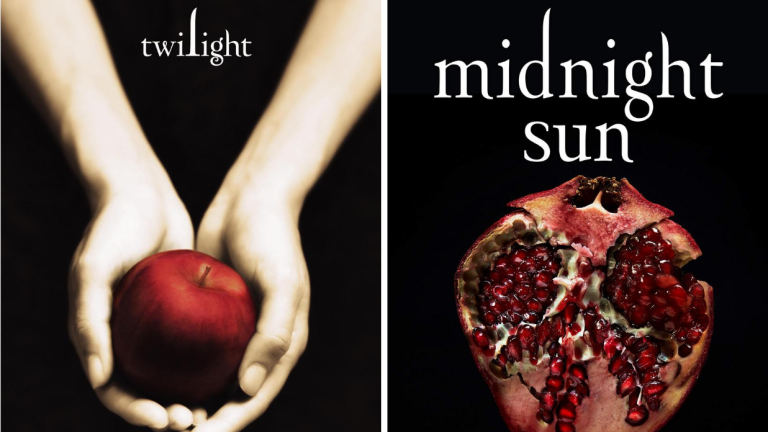Midnight Sun Review (Spoiler-Free)
Was it worth the wait to resurrect Stephenie Meyer’s retelling of Twilight through Edward Cullen’s golden eyes?

Like Edward Cullen, Midnight Sun is older than it looks. Stephenie Meyer’s retelling of Twilight, her iconic YA novel of female desire, from the perspective of the smoldering vampire lover was first teased back in 2008, around the release of the final book, Breaking Dawn. At the time, Meyer announced that she would not be finishing the manuscript, as the first twelve chapters had leaked online and she felt like she had lost control of the story. By the time she warmed again to the idea, over the intervening years, the project was again derailed by the emergence of E.L. James’ Fifty Shades of Grey (based on James’ Twilight fanfic) and its own reversed-perspective retelling, Grey.
Then, suddenly, this past May, it was announced that Midnight Sun would be published in just a few months. With no real context for why the book is finally seeing the light of day, it’s difficult to see the rushed timing as anything more than a cash grab. Over a decade after Bella Swan made her final choice, is it really worth resurrecting this book into a second life?
Unfortunately, the answer is: only for the most diehard Twilight fans, and even then it’s a stretch.
Part of Edward’s appeal in Twilight was his inscrutability, the fact that he played much of his motivations concerning Bella close to his unbreathing chest, except for when he felt the need to bellow that he was a monster and how could she love him, but he loved her too. Midnight Sun sheds some sparkling sunlight on that interiority, though by dint of being a retelling, the facts remain the same: Century-old vampire meets seemingly unremarkable human girl in high school biology class. Vampire seems repelled by girl, but it’s really a ruse to try to resist her overwhelming scent. Vampire fails, and forbidden love begins. Vampire refuses to have sex or otherwise get too close to human girl, for fear of tearing her to shreds in his passion. When other vampires come sniffing around girl, our vampire must push her away to save her, but the real way to save her requires him to get closer to her than he ever thought he’d have the self-control to be.
That said, it is genuinely a different perspective; where Bella was so oblivious to her own allure in Twilight, Edward is hyper-aware of everything. His constant cataloguing—of high-school minutiae, of every potential threat that could befall clumsy disaster-magnet Bella, of the hundreds of blushes that darken her skin—creates a high-strung narrative obsessed with not missing a single detail, lest it bring his carefully-crafted control crashing down around him. While he initially takes for granted his talent for reading people’s minds, the discovery that he cannot read Bella’s thoughts throws him off-balance. As the Twilight series has drawn ire for often making Bella a passive figure in her own fate, this turning of the tables—of Edward not knowing if she desires or fears him—is appreciated. Let him (figuratively) sweat a little.
But because these star-crossed lovers are so inexorably drawn to each other, it’s especially difficult to make a retelling that doesn’t just copy-and-paste the same dialogue but swap the pronouns and proper nouns. Meyer does what she can within the constraints that she created fifteen years ago. It helps that Bella sleeps, and Edward doesn’t; while we know that he creepily watches her for at least one REM cycle each night, he does spend some time away from her, with his own vampire family.
The Cullens are the only real aspect of the story that Meyer can expand. Unusual even by vampire standards, they are more than just a coven, even if they’re bound less by shared blood than by shared bloodlust (or, more accurately, their covenant to tame those predatory impulses). To this family tree Meyer adds leaves and blooms, building out the backstories of each Cullen, but especially Rosalie and Alice, through Edward’s strained and tender dynamics with each.
The one thing that Midnight Sun does is provide something of a reasonable context for Edward’s downright ridiculous protectiveness of his mortal love. Though he cannot read Bella’s mind, he can join his telepathic talent to Alice’s affinity for visions of potential futures; through his sister’s eyes, he can scan ahead to various hypothetical consequences of his actions. This lends a dramatic irony to how he goes about first avoiding, and then courting, and ultimately saving, Bella.
Yet even with this added advantage, at times Edward seems truly ignorant of how his words and actions pluck at Bella’s fragile emotions, not understanding why certain bouts of protectiveness make her go weak at the knees (when he assumes she should be quavering in fear) or get angry at being underestimated (when he expects her to think like a predator protecting prey). His own obliviousness is laughable, but a small price to pay for slogging through the same overwrought narrative.
Even Twilight fans will be hard-pressed to find enough that’s new and compelling about this retelling.
Midnight Sun swaps Twilight’s iconic cover—a girl cradling an apple, tempting symbol of forbidden knowledge—for a pomegranate, more graphic than suggestive: While the apple is whole, existing in the moment between plucking and first bite, the pomegranate has been cut in half and oozes out seeds. When this cover was first revealed, one might have thought that it was a nod to the shift in thinking that the archetypal apple in the Garden of Eden was actually, considering the Garden’s likely real-life location, more likely to be a pomegranate. A truly charitable reading of the cover design process would perceive the choice of fruit as reflecting the wisdom of hindsight, the effort to make a narrative more accurate with new information.
Instead, its purpose seems to be for Edward to recast Bella from Eve, yearning to better know the world into which she was created, to Persephone, who thought first of tart taste and only later of what it would mean to take that red juice inside herself. Both women are punished for their insatiable curiosity, but Eve with the curse of childbearing and thousands of generations; Persephone, by contrast, to forever move between the world of the living and the underworld, cursed to live parallel half-lives instead of one full one. (Edward, of course, styles himself as Hades, unable to see himself as anything but a steward for the dead mourning their lost lives.)
Of course, all of this has yet to unfold for Bella. Knowing how the Twilight series concludes, it’s difficult to remember that Midnight Sun retells only the first of four books, and that by its end not even Edward knows Bella’s ultimate fate. Honestly, it would have been better for everyone if Meyer had retold the entire series in one 600-page (or even, let’s be generous, 1,000-page) tome: Instead of retreading every single step like a slow, plodding human, go the vampire route and speed through the whole narrative, stopping to linger at the moments that actually required his side of the story.
Midnight Sun is available now from Little, Brown and Company or for purchase from Amazon.
